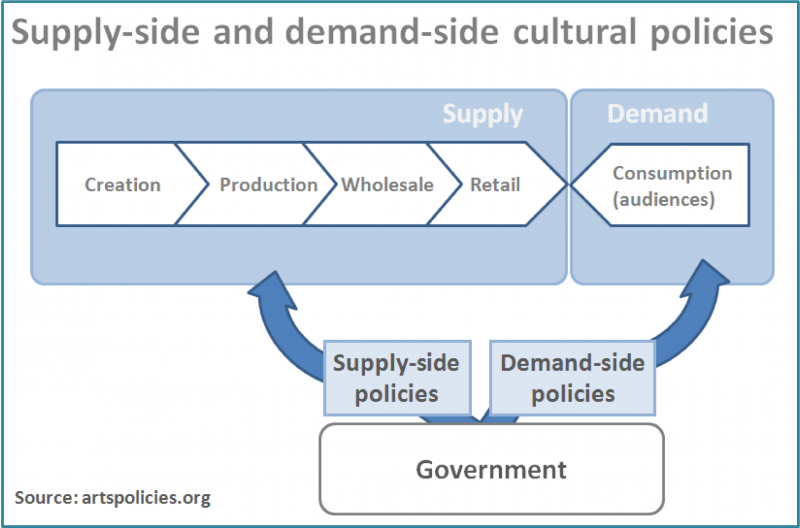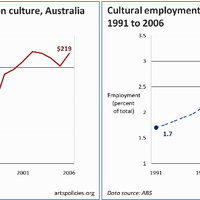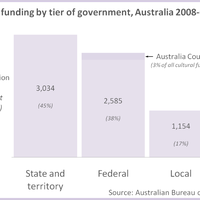Policies for boosting arts demand
 Policies that encourage arts demand can return balance to an oversupplied Australian arts sector and fix many of the ills of Australian cultural policy.
Policies that encourage arts demand can return balance to an oversupplied Australian arts sector and fix many of the ills of Australian cultural policy.These are interesting times for Australian culture. Creative arts participation in Australia has boomed, while at the same time professional artists’ relative incomes have declined. A boom in labour supply and a bust in incomes – these are classic symptoms of a sector suffering from ‘oversupply’ (or ‘hypercompetition’ as Ian Moss prefers to call it).
Cultural policy, too, seems to be at an interesting juncture. Some claim that Australian cultural policy is stagnant, out of touch and ‘upside down’. The Centre for Policy Development proposes reforming the Australia Council. The New Models New Money project calls for the establishment of an artists’ foundation. The reforms put forward by these groups are variations on the kind of ‘supply-side’ support that has dominated Australian cultural policy in the past. The problem is, if these types of policies have got us where we are today, more of the same is unlikely to make much difference. A more radical overhaul is needed.
‘Demand-side’ policies are the obvious answer. These can rebalance oversupply in the sector and bring flexibility to cultural policy.
What are ‘supply-side’ and ‘demand-side’ policies, and how do they differ?
Supply-side policies support creators, producers and distributors of culture – anyone along the arts industry ‘value chain’. Demand-side policies support cultural consumers – arts audiences, readers and attenders. The figure below illustrates the difference.
Subsidy, or grant-making, is the most obvious supply-side tool governments use to support Australian culture. But this is just one of a huge range of supply-side interventions in Australian cultural policy. All the prizes and awards, touring programs, copyright laws, tax breaks for producers and philanthropists, and local content rules – all these act on the supply-side. The major policy reviews of the ‘Howard era’ boosted supply (the reviews are described in appendices G6 to G12 of Jennifer Craik’s Re-Visioning Arts and Cultural Policy. Australia’s new resale royalty scheme is a supply-side policy.
Supply-side intervention is the bread and butter of Australian cultural policy.
Demand-side policies are not so common. These work on the other side of the cultural ledger by enticing people to attend, view, consume or participate in culture. They often target specific groups such as young people, infrequent consumers, or arts sceptics. Under demand-side policies, government support still ends up benefitting artists and arts organisations, but indirectly through audiences and consumers.
Culture ‘vouchers’ are the archetypal demand-side program. These work like any gift voucher, except that the voucher’s value comes from a funder rather than a retailer. A voucher can be redeemed for cultural goods and services and, when redeemed, the funder foots the bill. Vouchers can be thought of as a consumer subsidy rather than a producer subsidy.
Probably the most well-known cultural voucher scheme is the Dutch Culture Card. Under the scheme, a €25 card is given to schoolkids to redeem on cultural activities, either independently or with a school group. Students choose from 1,800 approved activities listed on an interactive website. The Test Drive the Arts programs run in South Australia and Queensland were variations on this type of scheme.
[caption id="attachment_13288" align="alignright" width="397" caption="photo by Louisa Bufardeci ; http://www.louisabufardeci.net/index.html"]
 [/caption]
[/caption]Visual art loans schemes are another example of a demand-side policy. These try to stimulate visual arts demand by providing interest-free loans for the purchase of art works. The Tasmanian government’s Collect Art Purchase Scheme is an example. Based on similar programs in the UK, in its first seven months the scheme provided loans for the purchase of 113 artworks.
Other demand-side schemes rely less on financial incentives and more on leading people to the arts or breaking down the barriers to arts participation. Many of the ‘audience development’ programs run by the Australia Council are examples of this. The Council’s Get Reading campaign aims to encourage people to read by offering recommendations, support materials and taster chapters. It provides a small financial ‘buy one get one free’ incentive.
There are obviously lots of other ways governments can intervene on the demand-side, but these examples give a flavour for some of the advantages demand-side policies have over supply-side policies.
The key difference is that supply-side policies support the making of cultural products, while demand-side programs support cultural experiences. Under supply-side schemes, it is possible that government support goes toward an art work that is witnessed by few people – perhaps even no-one besides the artist themselves, like a proverbial tree falling in a forest.
By funding consumption rather than production, demand-side initiatives ensure that support goes to art works that are both produced and experienced.
Demand-side policies also tend to be more democratic. Under supply-side policies, decisions are taken by expert panels (grants), philanthropists (some tax incentives), and bureaucrats and ministers (direct funding). With demand-side schemes, decisions about what receives public support are made by the general public, albeit from a ‘pre-curated’ list of approved arts products.
The difference in who decides can lead to profoundly different outcomes. Stretching the ‘tree in a forest’ analogy, consider the impacts of two different logging policies: one in which the government subsidises loggers to fell trees; the other in which citizens are given a voucher to pay loggers to fell trees. Over time, the two schemes are likely to produce two very different types of forest. In the same way, the subsidised arts sector will look very different depending on whether government support is determined by the preferences of producers, ‘elites’, or consumers.
Another advantage of demand-side policies is that they can leverage substantial private expenditure. Take the case of visual arts loans schemes. Rather than pay for an artwork outright, these schemes provide a financial incentive for the purchasing of artworks. The government pays the interest on the loan; the purchaser pays the principal. Loan schemes offer a carrot for households to dip into their own pockets, and by doing so tap into a potentially large pot of funds. The $282 million Australian households spent on visual arts in 2003-04 is twenty-six times Federal Government’s visual arts and crafts funding in that year. Leveraging household expenditure is a lucrative prospect for the arts.
Demand-side policies have one more major advantage. Research suggests that arts consumption is ‘addictive’, that arts experiences can lead to a taste for more arts (see RAND’s Cultivating Demand for the Arts). The effect seems especially strong in young people. Exposure to the arts at an early age is strongly correlated with adult arts participation. So, if demand-side programs succeed in getting bums on seats, they are likely to lead to repeat arts consumption – a sort of ‘multiplier effect’ on arts demand.
This boils down to a simple choice for arts funders: under a supply-side policy, spend $10 subsidising a potentially empty auditorium seat; or under a demand-side policy, spend $10 on a full seat today, and pay nothing for seats purchased in the future out of a recidivist’s own pocket.
All this suggests that demand-side policies can provide a much-needed rebalancing of Australia’s cultural sector and Australian cultural policy: they can directly mitigate the problems of sector oversupply by stimulating demand for the arts; they can bring extra funding to culture by tapping into a pool of private expenditure substantially greater than a highly-guarded pool of government funding; and they can diminish the power of vested interests within the cultural policy system by transferring some decision making power to citizens. Under their ‘democratising’ effect, government support would reflect a wider set of cultural preferences and could move more freely with the times.
This is not to say that demand-side policies are in every way superior – they can be administratively complex and cumbersome, and are prone to under-use. (How many unused coupons are buried in drawers, wallets and handbags across Australia?) What is needed is a better balance between the two types of policies and a targeting of each based on its relative strengths.
Currently, the policy mix is out of balance. Supply-side policies predominate, and are stimulating greater production in a sector already awash with supply. They may therefore be worsening the situation of professional artists. The few demand-side schemes currently operating in Australia are limited in number and scope. Giving these demand-side policies a boost and developing new demand-side initiatives should be an urgent priority for Australia’s cultural policy makers. And it should be a key direction for any national cultural policy.
Christopher Madden is a cultural policy research analyst and statistician. He has worked for a range of cultural policy agencies across Australasia. From 2001 to 2008 he was Research Analyst at the International Federation of Arts Councils and Culture Agencies.





